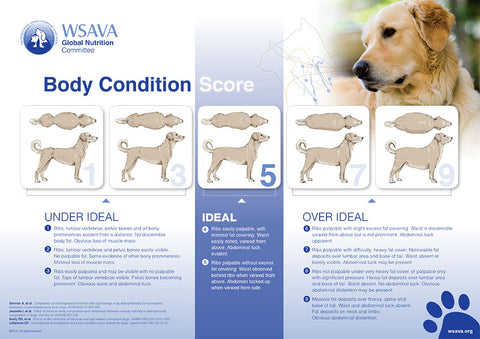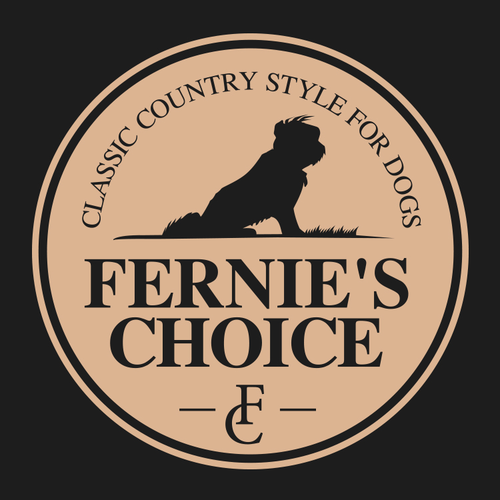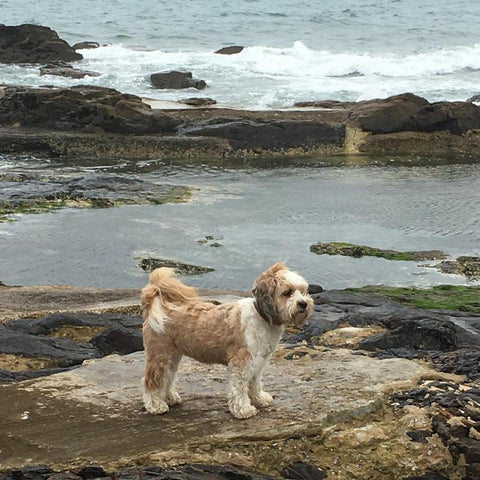Diet & Nutrition
It is important to monitor your dog’s weight and pay attention to their body condition over time to ensure you are feeding them correctly and that they are not under or overfed. Your vet will be able to tell you what a healthy weight is, but as a guide, you should be able to feel your dog’s ribs and see a waistline. The body condition chart below is a good indicator. In multi-dog households where one dog is eating the leftovers from another dog’s dinner, you may need to feed in separate rooms. Obesity can be costly, both in terms of veterinary bills and in health (increased risk of arthritis, diabetes and heart disease). If you think your dog may be overweight, your vet will be able to help you with a feeding and exercise plan.

What type of food should I feed?
There are many brands and types of dog food on the market that it may be difficult to know what is best to feed your dog. These include dry complete diets, wet food with or without biscuit mixer, and home-made food. On the whole, a good commercial complete food should provide all the essential nutrients for your dog. Dry food can be good for your dog’s teeth and so can be beneficial in some cases to a wet food only diet. Most foods are now available to suit the different life stages: puppy, adult, and senior. These have been formulated carefully to match the needs of your dog. Ensure you buy the correct one and make the transition to the next food gradually when required. A puppy should move on to adult food when it has stopped growing which is typically around a year old but this can be up to two years for large breeds. Do be guided by your food manufacturer as to the exact timing of this. Consistency with the type of food given is important so as to not cause an upset stomach. If you want to or need to introduce a new diet this should be done over the course of a few days to a week, starting with replacing only a small amount of the current food with the new food, and gradually increase the proportion of the new food. There is a growing trend for feeding home-made diets and raw diets but it’s important to recognise the difficulty in getting the nutritional balance correct so veterinary advice should be sought prior to feeding these types of diets.
How much and how often should I feed?
Guidelines on how much to feed your dog should be written on the food packet. These are guidelines only and you may need to adjust accordingly for your dog’s individual needs which will be affected by their activity levels and metabolism. You will need to monitor their weight and body condition. Consult your vet for advice if you are unsure of how much to feed. Daily quantities should be divided out across the number of meals you are feeding. Puppies should be fed small frequent meals throughout the day. For example, 3-month-old puppies are normally on four meals a day from about 12 weeks reducing to three meals a day over the next three months. At 6 months of age, they will then move on to two meals a day. Treats There are a wide variety of treats available commercially. These vary in quality and whilst some are relatively natural, others may contain a lot of sugar, milk products, and fat and all can increase your dog’s weight. Try to limit treats to rewarding good behaviour and always feed in moderation. Your dog’s normal diet should be reduced if treats are being fed. As a general rule, no more than 10 percent of your dog’s diet should be made up of treats. Healthy snacks such as fruits and vegetables are a good alternative as these are lower in calories. Examples of safe ones to feed include carrot, broccoli or apple (with core and seeds removed). It is best to avoid feeding table scraps as treats since many human foods can cause digestive upsets, contribute to obesity and unbalance your dog’s diet. Feeding a slice of toast, for example, is equivalent to a human eating a portion of French fries. If you have any questions regarding which treats to feed, do speak to your vet. It is not recommended to leave food out all day. Any uneaten food should be removed after about 20 minutes to ensure the food remains palatable and encourage good eating behaviours. Some dogs develop fussy eating habits. In most cases, this is down to an owner being too quick to offer something tastier. Be mindful of this and resist giving in to your dog. Ensuring food is only down for a set period will help your dog understand that is it not favourable to hold out, otherwise they will miss their meal altogether. Your dog should have access to water at all times so always leave their water bowl available and check it regularly. Dangerous and unsuitable foods There are a number of foods that we enjoy which can often be tempting to give to dogs, but some of these can cause digestive problems or be fatal.
Here is a list of some foods you should not feed your dog: • Chocolate • Caffeine • Grapes and raisins • Onions and garlic • Alcohol • Macadamia nuts • Food containing xylitol - an artificial sweetener

